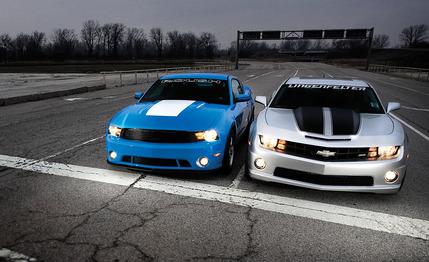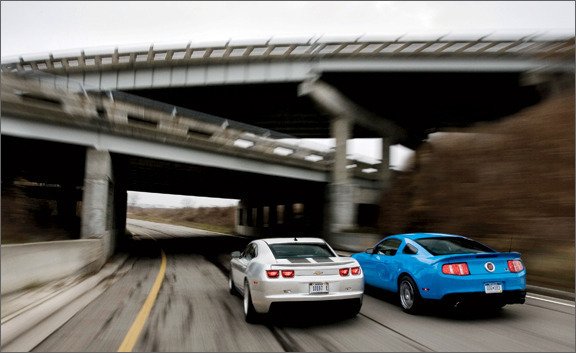
 Comparison Tests
Comparison Tests


Even though the auto industry is sputtering—along with the rest of the economy—there remains a cadre of horsepower junkies who always want more than the factory has delivered. The recent arrivals of a resurrected Camaro and a new Mustang have stoked this group’s desire for more tire-obliterating thrust.
Lingenfelter Performance Engineering (LPE) exists to satisfy such primal cravings. LPE has built a Camaro SS with its $10,995 TVS2300 kit, essentially a Magnuson/Eaton supercharger with high-flow fuel injectors, a cold-air induction system, a voltage-boosted fuel pump, and a recalibrated engine-management system. Though the engine is internally unchanged, the system’s 9 psi of boost is good for 570 horsepower.
To put those extra 144 horses to the pavement, the LPE car gets a host of other upgrades, including 20-inch wheels shod with Nitto NT05 tires ($4415), a 3.70 rear axle with heavy-duty half-shafts ($3484), a dual-disc clutch from a ZR1 Corvette ($1860), and a stiffer Hotchkis suspension ($1710). Add to that a Corsa exhaust ($1750), big Brembo brakes ($7940), and various lesser upgrades, and the mods ($34,539) just about double the Camaro SS’s sticker price ($35,125) for a total of $69,664.
The Roush Mustang Stage 3 doesn’t bite into your wallet quite as hard, coming in at $61,255, which amounts to $28,510 of Roush Performance upgrades and the $31,845 price of a specific Roush-ordered Mustang GT. This lower price isn’t due to less content. In fact, the Roush engine has been reworked more extensively than the LPE V-8 because in order to achieve similar power (540 horses) from its much smaller V-8 (4.6 liters), its supercharger must blow harder—up to 15 psi. To ensure that the more highly pressurized engine doesn’t bust its gut, it gets lower-compression forged pistons, forged connecting rods, and a forged crank. The Roush Stage 3 also gets the expected upgrades to its clutch, suspension, exhaust system, and wheel-and-tire package, though only the front brakes are bigger.


In addition to the go-fast bits, however, the Roush Stage 3 package also includes appearance upgrades ranging from aero bodywork to Roush-emblazoned gauges, upholstery, floor mats, and shifter. There’s even a kit full of Roush-inscribed tools that drops down from the trunklid.
Though ostensibly similar mechanically, the two cars have very different personalities, which is as it should be in the realm of Camaro versus Mustang. We are not ranking them here as we do usually because that struck us as meaningless—if you’re a dedicated Chevy guy, nothing is going to convince you to go out and spend twice the money for a modified Mustang. Still, driving the two back-to-back was illuminating.